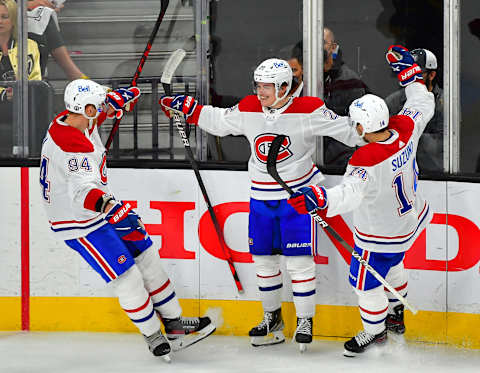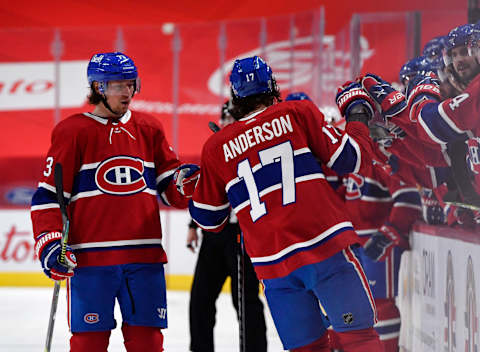Montreal Canadiens: What will the Habs’ power play look like next season?

Over the past few seasons, a weak spot for the Montreal Canadiens has been their power play. After finishing 17th in the league in power play percentage during the 2020-21 regular season, the Habs were 8th out of 16 teams during the 2020-21 playoffs. Although they were operating at a conversion rate of 18.9%, it was the timeliness of the Canadiens’ power play goals during the playoffs that counted the most. Some may refer back to the power play tally in Game 7 versus the Leafs to take a 2-0 lead.
After the firing of Kirk Muller last season, Alex Burrows took over the coaching of the Canadiens’ man advantage. Fans could see immediately the impact he made, as Montreal was starting to look more and more dangerous at 6 on 5 with Burrows at the helm.
With the departure of She Weber from the power play and the arrival of Mike Hoffman, it may be difficult at first for the Canadiens’ coaching staff to find the right combination of players to ensure that both power play units have the ability to make an impact. Rest assured however, that the Canadiens’ have more fire power than seasons pasts and should have no problem boasting a man advantage that can take over hockey games if they have proper deployment.
With the 2021-22 season fast approaching, let’s take a look at what power play units 1 and 2 could look like for the Habs.

Power Play 1:
Formation: 1-3-1 Umbrella
Personnel:
Caufield-Gallagher- Hoffman
Suzuki-Petry
Typically, Shea Weber was always the dangerous shooting threat on Montreal’s number one power play unit, but with #6 out of the picture it gives Burrows and co. the opportunity to create a man advantage similar to that of Tampa Bay’s with two one-timer options.
In terms of who the net front presence will be on the first unit, it is no question that Brendan Gallagher will assume that role. #11 has made a career from going to the dirty areas of the ice and is well suited for that position on the man advantage.
Jeff Petry has emerged as an elite offensive defenceman in the NHL and is a great fit to man the point on the power play. As power play quarterback, Petry would be able to feed both one-timer positions while also having the option to unleash a blistering shot of his own. His mobility at the blueline will get penalty killers moving and open up seams.
Nick Suzuki is developing into a premier playmaker in the NHL and has grown into a consistent point producer on the man advantage. Having Suzuki in the slot will allow him to move the puck to either one-timer positions on the half walls while also having the option to shoot. His vision and creativity will will keep the penalty killers guessing.
Rookie sensation Cole Caufield and new arrival Mike Hoffman should be penciled in as the trigger men on the first unit. Caufield and Hoffman should be positioned on opposite half walls presenting one-timer options to both Suzuki and Petry. With the two snipers possessing lethal shots, this formation should translate to a dominant power play for the Canadiens.

Power Play 2:
Formation: 1-2-2
Personnel:
Toffoli-Anderson-Kotkaniemi
Romanov-Drouin
Following the theme of power play unit 1, the Habs’ second man advantage also has the option of boasting two one-timer options. Tyler Toffoli, the Canadiens’ leading goal scorer from last season, and 21-year-old Jesperi Kotkaniemi would assume the shooting roles on the second unit.
Toffoli has a sneaky quick release, while Kotkaniemi possesses a very underrated one-timer from his off wing. With the two shooting roles taken care off, who will assume the net front presence? None other than 6’3″ 226 pound winger Josh Anderson. Anderson has shown Canadiens fans his heavy style of play and his ability to score in tight around the net. HIs heavy frame and silky hands would make him the perfect fit to screen opposing goaltenders, while also having the ability to pounce on loose pucks.
The back end of the second unit is where things get a little bit trickier. Jonathan Drouin has been the Canadiens power play quarterback in seasons pasts, primarily teeing up Shea Weber. I believe he is better suited for a role on the second unit where he is able to have another player run the blueline alongside him for extra support. This player would be emerging rookie Alexander Romanov.
Romanov has shown flashes of his offensive talent and heavy shot, and his confidence with the puck will only continue to grow. Alongside Drouin, the pair will be able to work the puck through the seams to the two one-timer options on the half boards. If the seams are taken away, Drouin will be able to tee up Romanov for a one-timer of his own.
Overall, the second unit has the fire power to be just as effective as the first. With the deployment of these two units, the Canadiens will be on the right track of solving their decade long problem of being able to roll out two power plays that can contribute.
Fucale looking for redemption with Capitals. dark. Next